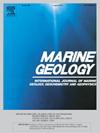从硅藻组合推断楚科奇海过去7600年的古海洋学演化
IF 2.2
3区 地球科学
Q2 GEOSCIENCES, MULTIDISCIPLINARY
引用次数: 0
摘要
楚科奇海在北极-太平洋的相互作用中起着至关重要的作用,由于持续变暖,楚科奇海目前正在经历海冰的显著退缩。本文介绍了楚科奇海中部沉积物岩心中硅藻组合和生物成因二氧化硅的记录,为全新世中晚期海冰和太平洋水流入(PWI)的长期动态提供了见解。我们基于硅藻的海冰条件重建显示,在7.6-1.3 cal ka BP有长期下降趋势,与生产力的波动增加相一致。这些变化可能是由温暖、营养丰富的PWI变化所驱动的,而PWI受海平面和大气环流的调节。全新世中期海平面稳定后,PWI变率主要受太平洋年代际涛动(PDO)模式和阿留申低压(AL)强度和位置的影响。值得注意的是,楚科奇海中部的海冰记录与东部地区的记录一致,但与全新世晚期北部地区的记录相反。这种跨区域海冰发展的非同步模式可能反映了环流模式的差异,例如PWI分支强度的变化和太平洋-大气动力学的显著变化。我们的发现有助于更好地理解全新世中晚期北极-太平洋地区大气和海洋过程之间的联系。本文章由计算机程序翻译,如有差异,请以英文原文为准。
Paleoceanographic evolution of the Chukchi Sea over the past 7600 years inferred from diatom assemblages
The Chukchi Sea plays a critical role in Arctic–Pacific interactions and is currently undergoing a significant retreat of sea ice due to ongoing warming. We present records of diatom assemblages and biogenic silica from a sediment core collected in the central Chukchi Sea, which provides insights into the long-term dynamics of sea ice and Pacific water inflow (PWI) during the middle to late Holocene. Our diatom-based reconstruction of sea ice conditions reveals a long-term declining trend at 7.6–1.3 cal ka BP, coinciding with fluctuating increases in productivity. These changes were likely driven by variations in the warm, nutrient-rich PWI, which is modulated by sea level and atmospheric circulation. Following the establishment of stable sea levels in the middle Holocene, PWI variability appears to have been influenced primarily by the Pacific Decadal Oscillation (PDO) pattern and the strength and position of the Aleutian Low (AL). Notably, the sea-ice records from the central Chukchi Sea align with those from the eastern region, but they contrast with records from northern areas during the late Holocene. This asynchronous pattern of sea-ice development across regions may reflect differences in circulation patterns, such as variations in the strength of PWI branches and significant shifts in Pacific Ocean-atmosphere dynamics. Our findings contribute to a better understanding the links between atmospheric and oceanic processes in the Arctic-Pacific region during the middle to late Holocene.
求助全文
通过发布文献求助,成功后即可免费获取论文全文。
去求助
来源期刊

Marine Geology
地学-地球科学综合
CiteScore
6.10
自引率
6.90%
发文量
175
审稿时长
21.9 weeks
期刊介绍:
Marine Geology is the premier international journal on marine geological processes in the broadest sense. We seek papers that are comprehensive, interdisciplinary and synthetic that will be lasting contributions to the field. Although most papers are based on regional studies, they must demonstrate new findings of international significance. We accept papers on subjects as diverse as seafloor hydrothermal systems, beach dynamics, early diagenesis, microbiological studies in sediments, palaeoclimate studies and geophysical studies of the seabed. We encourage papers that address emerging new fields, for example the influence of anthropogenic processes on coastal/marine geology and coastal/marine geoarchaeology. We insist that the papers are concerned with the marine realm and that they deal with geology: with rocks, sediments, and physical and chemical processes affecting them. Papers should address scientific hypotheses: highly descriptive data compilations or papers that deal only with marine management and risk assessment should be submitted to other journals. Papers on laboratory or modelling studies must demonstrate direct relevance to marine processes or deposits. The primary criteria for acceptance of papers is that the science is of high quality, novel, significant, and of broad international interest.
 求助内容:
求助内容: 应助结果提醒方式:
应助结果提醒方式:


